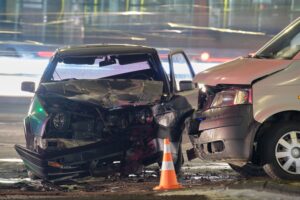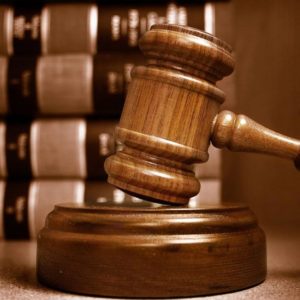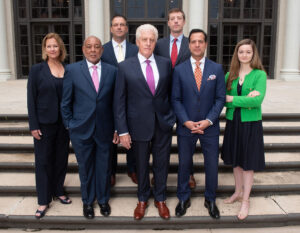If you’ve been seriously hurt in a car accident in Fairfax, Virginia, you might think your path to recovering compensation is straightforward. However, if you are found partly at fault for the accident that caused your injuries, that can complicate the situation, depending on where you live. Car accidents can be life-altering events, often leaving victims with physical injuries, emotional trauma, and financial burdens. The aftermath of a car accident becomes even more challenging when questions of fault arise.
Even if you fear partial responsibility, don’t let guilt prevent you from seeking justice – contact a Fairfax car accident attorney to understand your rights, how fault is determined, what the contributory negligence laws are in Virginia, and how they may affect the outcome of your case. Call Regan Zambri Long for a free consultation to discuss your claim.
Contact Us Today to Schedule
a Free Consultation

The contributory negligence rule in Virginia is one of the strictest in the nation. It means that even if the other driver was 99% responsible for the accident, you could still be denied compensation if you were found to be 1% at fault. This makes it essential to build a strong case that demonstrates the other party was entirely responsible for the accident.
Determining fault in a car accident is a critical step in any car accident injury claim, as it directly affects who is held financially responsible for damages. Fault is typically determined by a combination of factors and parties, including law enforcement officers, insurance companies, and sometimes the courts.
When a car accident occurs, police officers are often called to the scene to investigate. They will assess the situation, gather evidence such as witness statements, and document the scene. After their investigation, they usually file a police report that may include their assessment of who was at fault. While a police report is not the final determination of liability, it can be persuasive evidence used by insurance companies and attorneys.
Insurance adjusters play a significant role in determining fault after an accident. Each driver’s insurance company will investigate the incident, reviewing the police report, photos of the scene, damage to the vehicles, and any other relevant evidence. Based on this investigation, the adjuster will determine who they believe is responsible for the accident and to what degree. Even a small degree of fault can bar a plaintiff from recovering damages in states with contributory negligence laws.
Sometimes, the fault is unclear, and the parties involved may dispute the insurance company’s findings. If the issue of fault cannot be settled through negotiation, the case may go to court. In such situations, a judge or jury will examine the evidence, listen to testimony from both sides and ultimately decide who is liable for the accident. This legal determination is binding and will affect any compensation awarded.

Being wrongly named at fault in a car accident can be frustrating and can have serious consequences for your ability to recover compensation for your damages. If you believe that you were incorrectly blamed for causing the accident, there are steps you can take to challenge this determination and protect your rights.
If your insurance company determines you were at fault, you have the right to dispute their decision. Provide any new evidence or additional information that may have been overlooked during the initial investigation. Insurance companies are required to conduct a thorough investigation, and presenting new facts or correcting errors could change their determination of fault.
While rare, there are exceptions that might allow you to recover damages even if partly at fault:
The Last Clear Chance Doctrine is a legal principle that can allow a plaintiff to recover damages in a negligence case, even if they were partially at fault. This doctrine applies when the defendant had the final opportunity to prevent the accident but failed to do so. It’s particularly relevant in states like Virginia with strict contributory negligence rules. The doctrine focuses on the sequence of events leading to the accident, emphasizing the last actor who could have reasonably avoided the harm. It’s an important exception that can override contributory negligence defenses.
It’s important to note that while the Last Clear Chance Doctrine can be powerful, its application is complex and often depends on the specific facts of each case. In Fairfax, as in the rest of Virginia, courts will carefully examine the timeline of events and the actions of both parties to determine if this doctrine applies.
Gross negligence and willful and wanton conduct are important exceptions to the contributory negligence rule. These concepts represent levels of culpability that go beyond ordinary negligence.
Gross negligence is characterized by a conscious disregard for the need to use reasonable care, likely to cause foreseeable grave injury. Examples in driving contexts might include severe intoxication or excessive speeding.
Willful and wanton conduct, an even more serious category, involves a conscious decision to act in a way known to likely cause harm, such as street racing or deliberately causing a collision. Both of these can potentially allow a plaintiff to recover damages even if they were partially at fault for the accident, overriding the usual contributory negligence rule. Willful and wanton conduct may also open the door to punitive damages and often cross into criminal behavior.
While these exceptions can be powerful in overcoming contributory negligence, they typically require a higher burden of proof and careful examination of the specific facts of each case. Given the complexity of proving these levels of misconduct, it’s advisable for individuals who believe their accidents involved gross negligence or willful and wanton conduct to seek the guidance of an experienced attorney to build a strong case.

The attorneys at Regan Zambri Long can:
If you’ve been involved in a car accident in Fairfax, Virginia, understanding the impact of contributory negligence on your claim is vital. Even a small degree of fault can result in the dismissal of your claim, making it essential to demonstrate that the other party was entirely responsible for the accident.
Don’t let the Virginia’s contributory negligence law prevent you from seeking the compensation you deserve. Contact Regan Zambri Long for a free consultation. Their experienced team will evaluate your case and provide you with options for proceeding with your Fairfax car accident claim.